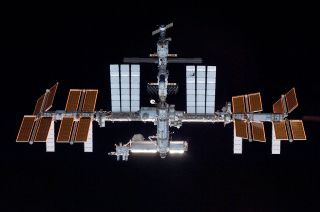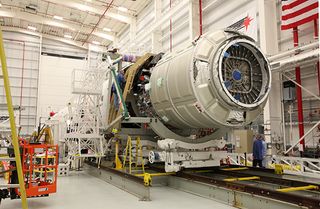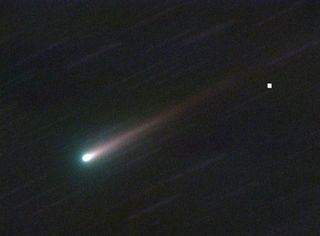NASA: Space Station Cooling Malfunction May Delay Private Cargo Ship Launch

The malfunction of a vital cooling system on the International Space Station could delay plans to launch a privately built cargo ship on its first official delivery mission to the orbiting lab next week, NASA officials said today (Dec. 12).
The space station malfunction occurred Wednesday (Dec. 11) when a coolant pump shut down, affecting half of the orbiting laboratory's cooling system one week before the planned launch of a commercial Cygnus spacecraft by the company Orbital Sciences. That mission, called Orbital 1, is slated to lift off Dec. 18 from Wallops Island, Va., to deliver fresh supplies to the space station.

Kenny Todd, head of NASA's space station mission management team, said officials are waiting for more information on the cooling system problem before making a decision on whether to proceed with the launch or delay the flight to allow repairs. The space station's current crew, which includes two Americans, three Russians and a Japanese astronaut, is not in any danger, he added. [How the Space Station's Cooling System Works (Infographic)]
"This is clearly an issue we need to deal with in its entirety before we commit to the launch of Orbital 1," Kenny Todd, head of NASA's space station mission management team, said in a NASA TV update today. "We're committed to doing that, and I think giving the team an extra day or so to think through what ways we might recover enough of the functionality to get comfortable with the launch is going to be our best course of action."
The International Space Station uses liquid ammonia to cool systems inside and outside the orbiting lab. That ammonia coolant is moved through cooling lines via pumps. On Wednesday, one of the two pumps shut down after it registered lower than normal temperatures.
Space station engineers suspect the problem is related to a flow control valve inside the pump and are attempting to diagnose the issue from the ground by commanding the valve to move through its various positions.
If the flow control valve issue continues to be a problem, it might require the astronauts to take a spacewalk outside of the station to fix the valve.
Get the Space.com Newsletter
Breaking space news, the latest updates on rocket launches, skywatching events and more!

Critical systems on the station are still up and running, but some secondary systems have been shut down, according to NASA. The space station's second cooling loop, Loop B, is still functioning normally.
"We haven't lost any primary functionality," Todd said. "This is a position we don't want to be in long term and so the team is continuing to work through the fault tree of what might be going on with this particular flow control valve."
In the meantime, Orbital Sciences officials are working to prepare for the upcoming Cygnus launch. Orbital has a $1.9 billion contract to provide eight cargo delivery mission to the space station for NASA using its unmanned Cygnus spacecraft and Antares rockets.

Orbital launched the first Antares rocket test flight in April, and followed that success with a demonstration flight of the Cygnus spacecraft in September.
The planned Dec. 18 launch of Cygnus from NASA's Wallops Flight Facility in Virginia will mark Orbital's first official cargo run.
Orbital Sciences is one of two private spaceflight companies with a contract to deliver cargo to the International Space Station for NASA. The other company is the Hawthorne, Calif.-based SpaceX, which has a $1.6 billion agreement to fly 12 cargo mission to the station for NASA using its robotic Dragon space capsules and Falcon 9 rockets. Two of those missions have already flown.
Editor's note: This story was updated to correct the description of the system malfunction at the top of the story at 1:40 p.m. EST (1837 GMT).
Follow Miriam Kramer @mirikramer and Google+. Follow us @Spacedotcom, Facebook and Google+. Original article on SPACE.com.
Join our Space Forums to keep talking space on the latest missions, night sky and more! And if you have a news tip, correction or comment, let us know at: community@space.com.

Miriam Kramer joined Space.com as a Staff Writer in December 2012. Since then, she has floated in weightlessness on a zero-gravity flight, felt the pull of 4-Gs in a trainer aircraft and watched rockets soar into space from Florida and Virginia. She also served as Space.com's lead space entertainment reporter, and enjoys all aspects of space news, astronomy and commercial spaceflight. Miriam has also presented space stories during live interviews with Fox News and other TV and radio outlets. She originally hails from Knoxville, Tennessee where she and her family would take trips to dark spots on the outskirts of town to watch meteor showers every year. She loves to travel and one day hopes to see the northern lights in person. Miriam is currently a space reporter with Axios, writing the Axios Space newsletter. You can follow Miriam on Twitter.
